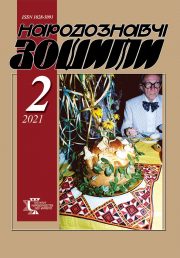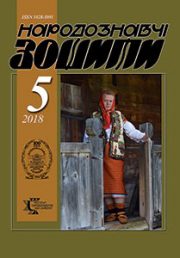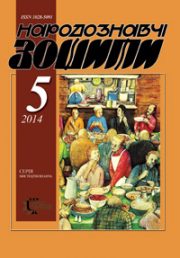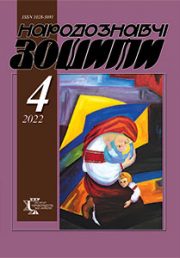The Ethnology Notebooks. 2024. № 3 (177), 605—616
UDK 7.012:727.7:7.045+745:069.013(477)(045)”20″
DOI https://doi.org/10.15407/nz2024.03.605
CORPORATE IDENITITY OF THE UKRAINIAN MUSEUMS IN THE VISUAL SPACE OF MODERN MUSEUM ACTIVITY
KUSHNIR Vitalii
- ORCID ID: https://orcid.org/0000-0001-8809-0108
- Candidate of Historical Sciences,
- Senior Research Fellow,
- Museum of Ethnography and Art Crafts at the Institute of Ethnology of the National Academy of Sciences of Ukraine,
- Svobody ave., 15, Lviv, 79000, Ukraine,
- Contacts: e-mail: vitaliy_val@ukr.net
Abstract. The complex of means by which museums seek to convey their «message» to the audience — informative, meaningful and valuable — can be defined as a museum language, the core of which is the visual component. The latter is formed not only by the museum exposition itself, but also by several other components which are in complex interaction with each other. The immediate visual space of a particular museum is part of its wider «virtual visuality», which exists in the space of social and modern telecommunications.
The purpose of the work is to characterize the newest corporate identity of Ukrainian museums, as well as to determine its place and role in the wide space of modern museum visuality.
The chronological framework of the work mainly covers the last few years, during which the identity of Ukrainian museums began to undergo rapid transformations. The research also required short retrospective excursions into the history of the museum business.
Conclusions. Museum expositions are the backbone of the visual component of the museum space. Their creation can be considered as a syncretic artistic genre in which the visual component is of key importance. At the same time, the visual dimension of the museum exhibition itself is an integral part of the wider space of museum visuality, it exists in a complex relationship with museum architecture and museum territories. In turn, the immediate visual space of a specific museum, including the architectural dimension, is part of its «virtual visuality», which is formed by the museum corporate identity and the virtual (informational) component of the museum’s functioning. Today, the creators of the newest Ukrainian museums corporate identity try to modernize the main visual signs of museum institutions stylistically, turning to specialists for this. Another characteristic point is the intention to give the identity a symbolic meaning. Ukrainian museums’ interpretation of their corporate identity is characterized by emphasis on its orientation towards a wider range of visitors, an appeal to the youth, stressing the element of creativity, as well as the connection with Ukrainian heritage, Ukrainian national elements in both the physical and virtual cultural landscape.
The research methodology is based on the complex of a number of principles and methods of museology and historical research, in particular, the comparative method, the principle of historicism, as well as art analysis, primarily visual and formal-stylistic. To achieve the stated objective, source-study, and the method of systematization of obtained data and results were also implemented.
Keywords: museum, museology, museum visuality, museum architecture, museum corporate identity.
Received 3.06.2024
REFERENCES
- Malanchuk-Rybak, O. (2013). Visual culture as a research object. Art historian’s autograph (Issue 6—8, pp. 99—106) [in Ukrainian].
- Mankovska, R., & Gavrilyuk, S. (2021). Theoretical foundations of museum visuality. Scientific notes of Mykhailo Kotsyubynskyi VDPU. Series: History (Issue 37, pp. 95—100) [in Ukrainian].
- Soshnikov, A. (2016). Modeling of an exposition image. Scientific Bulletin of KhNPU. «Philosophy» series (Issue 47, part II, pp. 3—7). Kharkiv: KhNPU [in Ukrainian].
- Smyrnyi, D. (2009). Museum exhibition design. Design of Central and Eastern Europe (Pp. 186—193). Kharkiv: KhDADM [in Ukrainian].
- Piven, V.O. (2016). Exhibition work in a modern museum: the problem of visualization and museum communication. STUDIA SLOBOZHANIKA. Bulletin of the exhibition and museum center. Materials of the International Scientific and Practical Conference «Slobozhansk Humanitarian-2015», November 27, 2015 (Vol. 2). Kharkiv [in Ukrainian].
- Velika, L. (2000). Museum exposition art. Kharkiv: KhDAK [in Ukrainian].
- Velika, L. (2000). Museum exposition art. Abstract… cand. myst. Kharkiv [in Ukrainian].
- Architectural concepts of modern museums. Museum space (Part 1). October 24, 2008. Retrieved from: prostir.museum/ua/post/28276 (application date: August 3, 2023) [in Ukrainian].
- Nogovitsyna, T.V., & Karpova, A.V. (2019). Principles of architectural and planning organization of modern museums. Regional problems of architecture and urban planning, 13, 92—100 [in Ukrainian].
- (1996). Guide to the University of Alaska Museum. University of Alaska Museum, Fairbanks.
- Cherkasy Regional Museum of Local Lore. Retrieved from: https://ckoblmuz.ck.ua (access date: May 8, 2024) [in Ukrainian].
- Malanyuk, V. (2021). Modern trends in the architecture of corporate museums. Current issues of humanitarian sciences (Issue 44, vol. 2, pp. 21—25) [in Ukrainian].
- Stakhova, O. What is a brand identity and how to create it. October 27, 2019. Retrieved from: www.lanet.click/aidentyka-brendu (application date: April 12, 2024) [in Ukrainian].
- Golovachko, M. Cultural marketing: how and why to change the visual image of theaters and museums. June 1, 2020. Retrieved from: https://mind.ua/openmind/20211270-kulturnij-marketing-yak-i-navishcho-zminyuvati-vizualnij-obraz-teatriv-i-muzeyiv (date of application: March 18, 2024) [in Ukrainian].
- Vezhbovska, L., & Osadcha, T. (2021). Rebranding of Ukrainian art museums: design as a cultural strategy. Demiurge: ideas, technologies, design perspectives, 2 (Vol. 4, pp. 177—196) [in Ukrainian].
- Now NAMU: Banda Agency has created the brand identity of the National Art Museum. Sofia Pylyp’yuk, December 20, 2018. Retrieved from: https://www.the-village.com.ua/village/culture/art/279967-namu-identity (access date: May 3, 2024) [in Ukrainian].
- Stasiuk, I. The Kyiv Museum received a new brand identity: stickers and mustard-green colors. 18.11.2020. Retrieved from: https://hmarochos.kiev.ua/2020/11/18/muzej-kyyeva-otrymav-novu-ajdentyku-stykery-ta-girchychno-zeleni-kolory/ (date of application: May 3, 2024) [in Ukrainian].
- Lesyshyn, I. The Khanenko Museum has a new brand identity: who and how created it. October 16, 2019. Retrieved from: https://www.the-village.com.ua/village/culture/art/ 290223-u-muzeyu-hanenkiv-nova-aydentika. (application date: April 28, 2024) [in Ukrainian].
- Yefremova, V. Rebranding of the Pedagogical Museum of Ukraine. 26.01.2021. Retrieved from: http://pmu.in.ua/actual-info/rebrendung/ (access date: March 28, 2024) [in Ukrainian].
- Hlushcnenko, A. Rebending is a word and image: rebranding of the Pedagogical Museum of Ukraine. Retrieved from: https://cases.media/case/komunikaciya-ce-slovo-ta-obraz-rebrending-pedagogichnogo-muzeyu-ukrayini (date of application: May 3, 2024) [in Ukrainian].
- Minimalism and the sea: the Odessa Art Museum received a new visual style. 05/31/2019. Retrieved from: https://www.the-village.com.ua/village/culture/culture-news/285657-minimalizm-ta-more-v-odeskogo-hudozhnogo-muzeyu-noviy-vizualniy-stil. (application date: July 11, 2023) [in Ukrainian].
- Fibonacci spirals were combined with a wave: a new brand appeared in the Odessa museum. Retrieved from: https://odesa.depo.ua/ukr/odesa/spiral-fibonachchi-obednali-z-khvileyu-v-odeskogo-muzeya-zyavivsya-noviy-brend-20190530971139 May 30, 2019 (date of application: July 11, 2023) [in Ukrainian].







